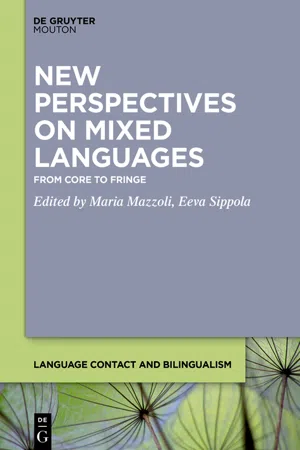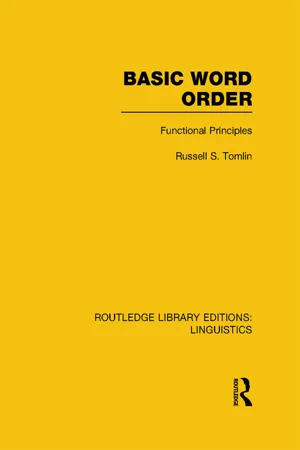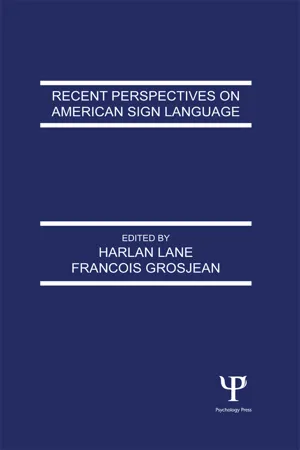Languages & Linguistics
Object Subject Verb
"Object Subject Verb" refers to the word order in a sentence where the object comes before the verb. This word order is commonly found in languages such as Japanese and Turkish. In this structure, the subject typically follows the verb. This word order is different from the more common Subject Verb Object order found in English and many other languages.
Written by Perlego with AI-assistance
Related key terms
3 Key excerpts on "Object Subject Verb"
- eBook - ePub
New Perspectives on Mixed Languages
From Core to Fringe
- Maria Mazzoli, Eeva Sippola, Maria Mazzoli, Eeva Sippola(Authors)
- 2021(Publication Date)
- De Gruyter Mouton(Publisher)
VO vs. OV: What conditions word order variation in Media Lengua?
Isabel DeibelThe Pennsylvania State UniversityAcknowledgements: This research was supported by a LeClaire (Lee) B. Watts Endowed Scholarship in Romance Languages, a Penn State Center for Global Studies Fellowship, and a Penn State External Funding Incentive Award. I am particularly grateful for the help of Gabriel Cachimuel, José María Casco and Antonio Maldonado during data collection, and I thank John M. Lipski and Rena Torres Cacoullos for their guidance and support with this project, and Jesse Stewart for providing helpful comments on an earlier version of this manuscript.1 Introduction
Every thought that a speaker wishes to communicate needs to be linguistically encoded in a specific linear order. While there are various possible orders of subject (S), verb (V) and object (O) in transitive declarative clauses, the majority of the world’s languages follow two predominant word orders: (S)OV (565/1377, e.g. Quechua,1 Basque, Japanese) and (S)VO (488/1377, e.g. English, Spanish), with some (189/1377, e.g. German, Dutch) allowing more than one predominant order (Comrie 1989 ; Dryer 2013 ; see also Goldin-Meadow et al. 2008 ; Langus and Nespor 2010 ; Schouwstra and de Swart 2014 ). If more than one order is possible in a language, variation in constituent order may be conditioned by pragmatic-stylistic factors (e.g. emphasis) or related to language contact.This paper examines word order variation in Media Lengua, a mixed language spoken in Highland Ecuador. In the Imbabura province (Northern Ecuador), Media Lengua has been documented in three communities: Angla, Casco Valenzuela and Pijal. These three villages are close to San Pablo del Lago, lying within a radius of 5 mi/8 km. Many participants in the current data set as well as in data collected by other authors indicate that close family and commercial ties between these three communities may have led to the spread of Media Lengua from Pijal to Angla and Casco Valenzuela (Stewart 2011 ; Lipski 2016 ; Deibel 2019 ). In addition, previous research has noted that speakers in Pijal appear to have shifted more to Spanish (Gómez Rendón 2008b ; Müller 2011 ; Lipski 2016 - eBook - ePub
Basic Word Order (RLE Linguistics B: Grammar)
Functional Principles
- Russell S Tomlin(Author)
- 2014(Publication Date)
- Routledge(Publisher)
In SVO and SOV languages, placement of modals that would separate the object from the verb are forbidden. English can be used to illustrate the general pattern: Steele catalogues a substantial number of SVO languages that follow this pattern: Modal placement in SOV languages tends also to be consistent with VOB:However, in VSO languages, modal elements may sometimes, as in (82), separate the object from the verb. But if modal elements do separate the object from the verb in some language, they also separate the subject and verb:Steele provides no data concerning VOS languages, but in Toba Batak modals precede the verb obligatorily:Finally, Steele’s analysis of Thai is not complete. While most modals in Thai do precede the verb, there are several which may follow it. However, these modal elements must follow the entire VO complex. Thus, the one example that varies from the general patterns Steele observes varies from those patterns in a manner totally consistent with VOB.Proverbal ReplacementsIt is possible in some languages to replace a verb+object phrase by a proverbal form. In no case has it been observed that a proverbal form can replace a subject+verb phrase in a transitive clause. If there were no special syntactic relationship between object and verb, there should be an equal possibility of observing either verb-object or verb-subject proverbal replacements. The data reveal, however, that there is not an equal possibility for each type of proverbal replacement. Therefore, some special relationship must exist between verb and object. The VOB principle states what the relationship is.Illustrative data for proverbal replacement comes from English: Movement ConstraintsThe data presented in this section demonstrate the cohesiveness of verb and object (as opposed to verb and subject) with respect to their sensitivity to movement rules. In the case below there is a movement rule sensitive to the bond between object and verb, but no parallel evidence of any such sensitivity to a verb-subject relationship. As in the cases above, this behavior can be explained by the VOB principle. - eBook - ePub
- Harlan L. Lane, Francois Grosjean(Authors)
- 2017(Publication Date)
- Psychology Press(Publisher)
Fischer’s paper basically argues that ASL has become a Subject-Verb-Object (SVO) language like English, possibly through increasing influence from English itself. Fischer constructed sign sequences and presented them to native signers for interpretation. The presented sentences consisted of various permutations of two nouns and a verb: NVN, NNV, VNN. (When either of the two nouns can be interpreted as subject or object, the sentence is referred to as “reversible,” e.g. “John kicked Bill,” but if only one noun can logically or reasonably be considered the subject or object, the sentence is “nonreversible,” e.g. “John kicked the chair.”) Fischer reports that the interpretations provided by her informants were as follows:1. NVN was interpreted as SVO. 2. NNV was interpreted as either a) conjoined subject-verb (N and N V), or b) OSV 3. VNN was interpreted as either a) verb-conjoined object (V N and N), or b) VOS Fischer’s (1975) conclusions from these interpretations was that ASL is an underlying SVO language. This does not mean that SVO is the only allowable surface word order: “Other orders are allowed under the circumstances that (a) something is topicalized, (b) the subject and object are non-reversible, and/or (c) the signer used space to indicate grammatical mechanisms [p. 21],” Variations from the basic SVO order can be signaled by “intonation breaks,” which Fischer characterizes as consisting of pauses, head tilts, raised eyebrows, and/or possibly other nonmanual cues. Thus NVN is interpreted as SVO, contains no breaks, and is considered the underlying order. N,NV may be interpreted as O,SV with the object topicalized and a break between it and the remainder of the sentence (an example of a topicalized object in English would be “As for the rhubarb, John ate [it]”). The sequence VN,N may be interpreted as VO,S with a topicalized verb phrase, followed by the subject with a break after the verb phrase (symbolized by the comma). (An example of a topicalized verb phrase in English would be “As for doing the dishes, John will.”) In discussing Fischer’s data, Liddell (1977) notes that although these three orders include the subject in all three sentence positions, initial, medial, and final, this does not indicate random word order in ASL. Instead, he adds the observation that “if the subject or object accompanies the verb, the subject precedes the verb and the object follows the verb [p. 109].”
Index pages curate the most relevant extracts from our library of academic textbooks. They’ve been created using an in-house natural language model (NLM), each adding context and meaning to key research topics.


